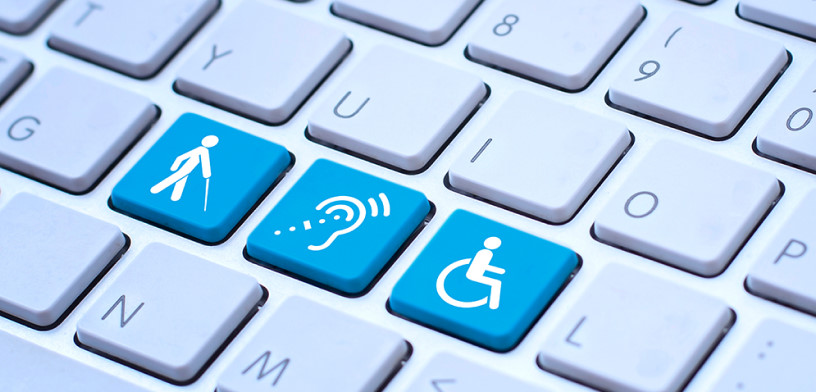Digital accessibility:
3 things you can optimise today
Written by William ElegeertMarch 30 2022

Around 35% of the Dutch population has a disability. That correlates to about 6 million people who may experience problems while visiting websites. This is due to disabilities such as deafness, poor vision, dyslexia or low literacy. By working on digital accessibility, you provide an inclusive website. Because everyone is welcome, right? Discover what you can work on today to make websites more accessible!
What is digital accessibility?
Digital accessibility entails that everyone can use the information on a website. Also, when they have to live with a disability. Digital accessibility ensures that a website is optimised for this group of people. For example, you can add alternative texts (alt text) that describe an image. It ensures that text-to-speech software can convey this text to a visually impaired individual. Digital accessibility thus prevents the exclusion of a large group of people.
For websites and mobile applications, digitally accessibility has been mandatory for Dutch government agencies since 2021. With the upcoming European legislation, the European Accessibility Act, from 2025, a legal obligation will come into effect for all companies. It is a new condition that sometimes requires changes but offers many advantages too. Good to already get started with this.
What are the benefits of digitally accessible websites?
The main advantage is that a large group of people can use the website and content. However, making your website more accessible has additional benefits.
- It increases your audience
More people can use the website, which increases its reach. It also results in more people having the ability to convert. - It improves findability in search engines.
It is with good reason that people say: “What is good for the user is good for Google.” Some optimisations, such as adding alt texts, contribute positively to findability. Provided it is applied well. - It contributes to your reputation and customer loyalty
Research by Forbes shows that 88% of the respondents have a higher feeling of loyalty to businesses that engage in social acts. - It makes a website future-proof
Given the approaching ageing population, a larger group of Dutch people may also have to deal with visual impairments - It ultimately saves costs
Optimising a website might require investment now, but this will pay off in the long term due to a big group of people using your website without needing extra help or information service. This saves costs of other communication channels, such as a helpdesk.

Checklist for a digital accessible website
So, enough reasons to get started with a website is that accessible for everyone. Are you designing a new website or do you want to optimise the existing website? This mini checklist will allow you to move towards a digitally accessible website rapidly.
1. Accessible language and text
Text is a significant part of a website. It provides structure and information. Adding text makes a website quite accessible already. Texts are easy to process for assistive technology. Think of reading the text out or automatically translating it. However, there are some things you should keep in mind.
- Choose the correct language and use a level that suits the target audience. Most Dutch people have a language level of B1.
- Ensure text has a clear layout – page titles, subheadings, and lists, that can provide better clarity.
- Check whether the text layout is correct and if it contains the proper HTML coding. Think of H1, H2, H3, et cetera. It allows technology, such as a screen reader, to read the text properly.
- Make sure it has fitting titles and headings that describe the content.
- Display whether your website is also available in other languages.
2. Clarification of image and sound
It is not for nothing that the saying goes, “A picture is worth a thousand words.” By adding images, infographics and videos, you visually convey your message. Keep the following things in mind:
- Choose to make the complex text more simple using imagery or a video. For example, an infographic, a how-to-video or a tutorial video.
- Add an alternative text to an image or video. It allows a reading software to read the text out loud or a programme to convert the alt-text to braille. For those who can not see the image, the message does come across.
- Describe both the image’s function and message: what it does and shows.
- Provide a video with subtitles. Preferably subtitling that describes events in the video for people that have a hearing impairment.
- Add a transcript to a video, so the content of a story can be read out loud.
- Use an audio description. It describes the video setting and tells all the visual aspects you do not hear.
3. User Experience: Simple UX
Make a website accessible by creating a good User Experience (UX). Research the flow of a website and learn about your target audience. In short, learn and understand how people use your website. For example, keep the following things in mind.
- Research the online findability of websites: is the information easy to find?
- Let experts work on conversion rate optimisation. Does your website have a lot of users, but they do not convert? Then there may be communication, technical, or flow errors.
- Check the navigation structure – is it logical, is the flow correct and is it what people expect?
- Choose the right fonts and colours. People with dyslexia might have trouble reading some fonts. In addition, some colour contrasts might be so low that people might experience difficulties separating them.
- Add an internal search feature to the website.
- Create forms with targeted instruction, logical flow, predictable functioning and easy submission. Ensure there is little to no distraction whilst filling in a form. Think of leaving out moving banners or redundant information.
Getting started with
Digital accessibility?
Keep digital accessibility in mind whilst designing your website. Develop an inclusive website that reaches more people, converts better and generates more revenue ultimately.
Are you getting started with a new website? Do you want to improve an existing website? SowiesoDigital is keen to help with this and guarantees that your story is right from A to Z. Want to learn more? Contact us for a non-binding conversation.